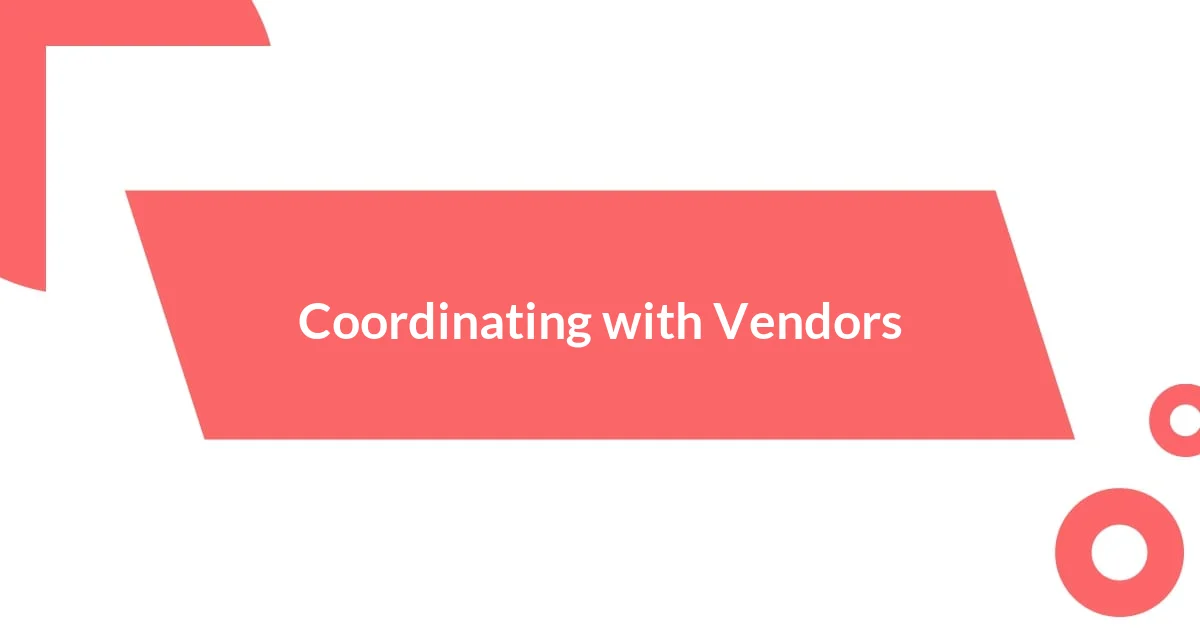Key takeaways:
- Planning the event timeline with detailed schedules and buffer periods is crucial for managing unexpected delays and ensuring smooth operations.
- Establishing clear communication and strong relationships with vendors enhances coordination, allows for proactive problem-solving, and mitigates stress during the event.
- Engaging the audience through interactive elements, storytelling, and networking opportunities significantly enhances the overall experience and fosters meaningful connections.

Planning the Event Timeline
When I started planning the event timeline, I quickly realized how crucial it was to map everything out in detail. I dedicated a weekend to creating a clear schedule, breaking down each phase of the event to avoid any last-minute surprises—because, trust me, those can turn a dream event into a nightmare. Have you ever left something to the last minute only to feel the weight of the world on your shoulders? I certainly have, and it’s not something I wanted to repeat.
One essential part of my timeline was including buffer periods between major activities. This approach ensured we had enough breathing room for unexpected delays or overruns, which tend to happen more often than we’d like to admit. I remember one year when a keynote speaker was running late. Thankfully, my careful planning allowed us to adjust without anyone noticing, turning a potential disaster into just another day at the office.
I also learned the importance of communication within the timeline. Keeping everyone informed about their roles and deadlines was key. I created a shared document and sent out reminders, which ended up being instrumental—everyone felt included and knew what to expect. I’m curious, how do you keep your team in the loop? Collaborative tools can really make a difference in ensuring everyone is on the same page!

Setting a Realistic Budget
Setting a realistic budget is often a make-or-break factor in planning a successful corporate event. I’ve learned from experience that underestimating costs can lead to sleepless nights and a frantic scramble for last-minute funding. When I managed my first corporate gathering, I ended up overspending in areas I hadn’t considered, like technology rentals and catering. This time, I created a detailed budget spreadsheet that allowed me to track every penny and stick to my financial limits.
Here are some essential elements to consider when setting your budget:
- Venue Costs: Factor in rental fees, security deposits, and any service charges.
- Catering Expenses: Don’t forget about drinks, waiting staff, and potential gratuities.
- Technology Needs: Include costs for audiovisual equipment, Wi-Fi, and technical support.
- Promotional Materials: Allocate funds for print materials like programs and banners.
- Miscellaneous Fees: Always have a buffer for unexpected expenses—trust me; they will arise!
By paying attention to these details, you reduce the stress associated with financial surprises, allowing you to focus on what truly matters: creating an unforgettable event.

Choosing the Right Venue
When choosing the right venue, I always consider the overall vibe I want to create. For example, a sleek, modern conference center sets a professional tone, while a cozy boutique hotel might spark creativity and innovation. A few years ago, during an annual corporate retreat, I picked an unexpected venue—an art gallery. The ambiance encouraged open dialogue, and the attendees appreciated the unique setting. Have you ever thought about how a venue can shape the interactions that happen during an event?
Another crucial factor is location. Accessibility is key; you want your venue to be easy for attendees to reach, especially if many are coming from out of town. For one of my previous events, I mistakenly booked a venue far from the city center, assuming it would offer a peaceful retreat. Unfortunately, this turned into a logistical challenge, with guests struggling to find transportation. I learned that it’s always worth checking for nearby public transport options or parking availability.
Lastly, I can’t emphasize enough the importance of size and capacity. It’s better to have a little extra space than to feel cramped. I remember one event where the venue was just barely large enough for our group. While the atmosphere was intimate, it left little room for movement, making networking a bit awkward. Ensuring the venue fits your guest list while keeping comfort in mind can really enhance the event experience.
| Venue Type | Pros |
|---|---|
| Conference Center | Professional, equipped with necessary facilities |
| Hotel | Convenient accommodation, sometimes offers packages |
| Outdoor Space | Scenic, unique ambiance |
| Art Gallery | Stimulating environment, opens creative dialogue |

Coordinating with Vendors
When it comes to coordinating with vendors, clear communication is absolutely essential. I always make it a point to establish a solid relationship right from the start. For instance, during my last event planning experience, I took the time to meet with the catering team ahead of time. I didn’t just discuss the menu; I shared my vision for the event. This laid the groundwork for an open dialogue, and I felt confident that they truly understood my expectations.
Follow-up is another key aspect I prioritize. I remember a situation where I secured a decorator, but a few weeks before the event, I hadn’t received any updates. I reached out to clarify our arrangements, only to discover some details had been overlooked. That little nudge not only brought us back on track but also helped me develop a stronger partnership with the vendor. Have you ever had that nagging feeling that something might slip through the cracks? Those check-ins can save a lot of stress down the line.
Being proactive in problem-solving is vital as well. During a past experience, our audiovisual supplier faced a last-minute equipment failure just hours before the doors opened. Thankfully, I had established a relationship built on trust and open communication. When I called, they quickly helped me troubleshoot and even provided a backup solution, preventing a potential disaster. I learned that having a reliable vendor network can be your lifeline, allowing you to handle unexpected challenges with ease.

Engaging the Audience
Engaging the audience is at the heart of any successful corporate event. From my own experience, I’ve found that incorporating interactive elements can transform passive listeners into active participants. For instance, at one of my workshops, I prompted attendees to share their thoughts on a specific topic through live polling. The immediate feedback not only sparked interesting discussions but also made everyone feel valued and heard.
I also believe that storytelling plays a critical role in audience engagement. When I was presenting a case study, I wove in personal anecdotes that were relatable to my listeners. Not only did this capture their attention, but it also made my message resonate on a deeper level. Have you ever noticed how a good story can make a dull topic come alive? It’s amazing.
Another strategy I’ve employed is to create opportunities for networking. After one event, I organized a casual mixer where participants could connect over refreshments. The atmosphere was relaxed, which encouraged authentic conversations. The feedback I received afterward was overwhelmingly positive; people appreciated having that chance to form meaningful connections. Isn’t it incredible how a simple shift in format can enhance engagement?

Managing Onsite Logistics
Managing onsite logistics can feel overwhelming, but I’ve found that a structured approach makes all the difference. For instance, during my last event, I created a detailed schedule that outlined every aspect of the day, from vendor arrivals to guest registrations. Imagine the chaos if I hadn’t—juggling multiple elements without a clear plan can really send your anxiety levels skyrocketing.
In my experience, a good way to manage logistics is through a designated point of contact for each vendor. During one event, I assigned a team member to liaise with the AV crew, which streamlined communication significantly. By having someone responsible, I could focus on other event aspects without worrying that important messages or changes would be lost.
Have you ever noticed how even small details can lead to big impacts? At a corporate gathering I managed, we nearly ran out of name tags right before the attendees arrived. Thankfully, I had anticipated a larger turnout and had a contingency plan in place. That experience taught me the value of always being prepared for last-minute changes—because in event planning, it’s not a matter of if something will go wrong, but when.

Gathering Feedback After the Event
Feedback is an essential part of improving future events. After one particularly memorable conference, I sent out a survey to participants, asking them what they enjoyed and what could be improved. Surprisingly, the responses were full of gratitude, but I also learned about elements I had overlooked—like the need for more breakout sessions. Isn’t it fascinating how constructive criticism can open doors to new ideas?
Incorporating real-time feedback can be incredibly valuable as well. During a recent event, I set up a feedback station where attendees could leave comments anonymously throughout the day. This not only provided immediate insights but also encouraged those who may not have spoken up otherwise. I still remember one attendee expressed how grateful they were to have a quieter space for discussions, which was something I hadn’t considered. It really shows how essential it is to create an inclusive atmosphere, doesn’t it?
Moreover, I’ve found face-to-face interactions to be incredibly revealing. After the last event, I took some time to chat with guests as they were leaving. Their candid thoughts were eye-opening! It made me realize how valuable those organic conversations can be—there’s something about personal dialogue that just feels richer than a typed survey. Engaging directly can add depth and nuance to the feedback process that surveys alone might miss. So, how have you gathered feedback in the past? Have you found that personal touch makes a difference?















